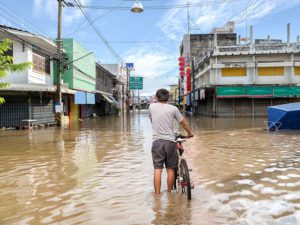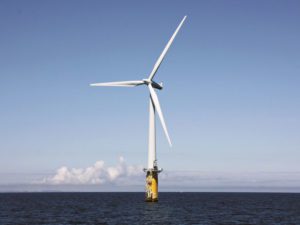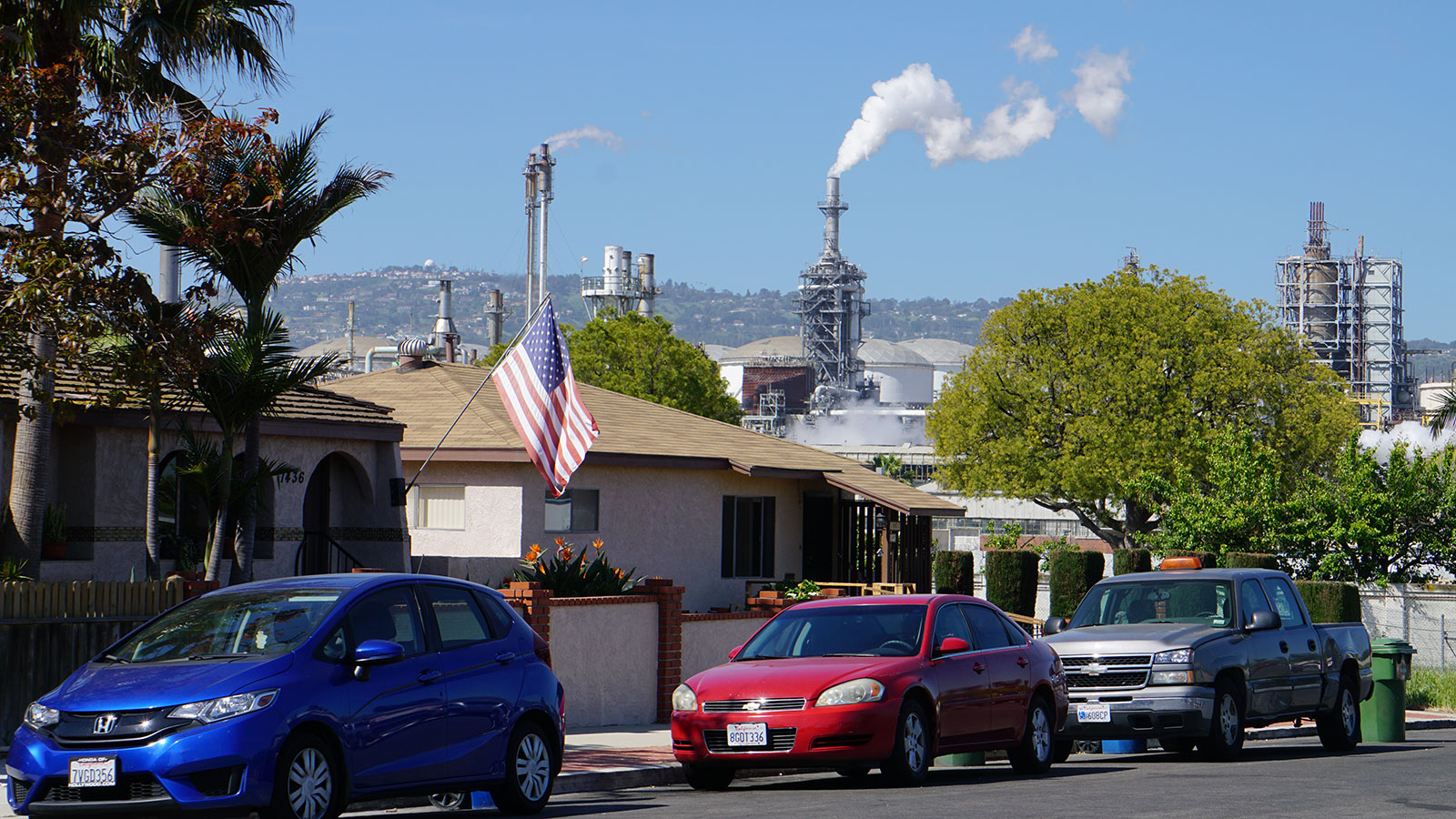
Wilmington, CA, a predominantly Latinx neighborhood, is surrounded by the Port of Los Angeles, heavy industry, and an oil field. Photo: Emmett Institute
Centering environmental justice and ensuring equitable outcomes is a sought-after goal for many stakeholders involved in the clean energy transition. Eddie Ahn, Executive Director of Brightline Defense clarifies misconceptions and shares best practices for ensuring that local communities have a seat at the table.
The organized labor and environmental justice communities in California have generally embraced offshore wind as an opportunity to create new jobs, reduce air pollution, and advance the clean energy transition. What is needed to ensure the equitable development of offshore wind in California?
There are very specific sites proposed for offshore wind in California. The first step is to consider the local communities that offshore wind siting will affect and understand the economic and workforce development benefits that can occur for local communities. Typically, a local community group will, in essence, negotiate with a developer about what community benefits will look like. This is an instance for which there is a complexity and scale to these projects: a lot of benefits could accrue to local communities situated near offshore wind installations.
For this reason, you want a blend of benefits to ensure that there are positive, long-term pathways for local underemployed and unemployed communities. This is why you see the alignment of labor and environmental justice on offshore wind. When we talk about new job pathways in a clean energy sector, we should prioritize hiring communities and workers that currently rely on fossil fuel industries, as well as local communities most burdened by the climate crisis.
When we talk about new job pathways in a clean energy sector, we should prioritize hiring communities and workers that currently rely on fossil fuel industries, as well as local communities most burdened by the climate crisis.
There is sometimes a tendency to gloss over the challenging parts of advancing environmental justice from an operational standpoint. What are the difficult truths of what this looks like in practice?
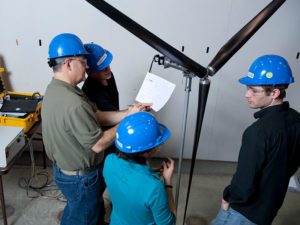
An engineering team constructs a scale model turbine to be tested. Photo: William Drake Photography
The challenges are two-fold. First, there is the question of retraining: we need to understand the different skillsets that are required for whatever new clean energy industry is being proposed and map out what a retraining program could look like. Second, you need to consider if these jobs are long-term careers. This is the power of organized labor in that it has established career pathways and protections for its workers. At Brightline, we are in support of ensuring that workers involved in this sort of back-breaking labor can earn healthcare benefits and a retirement.
The one-to-one transition between fossil fuel industries and clean energy is not always an easy one. It requires a lot of nuanced planning as well as resources; this type of retraining requires time and investment on the part of the whole system to adapt the current workforce.
The one-to-one transition between fossil fuel industries and clean energy is not always an easy one. It requires a lot of nuanced planning as well as resources; this type of retraining requires time and investment on the part of the whole system to adapt the current workforce.
How can marine conservation NGOs and funders support environmental justice as part of the clean energy transition in California? What would engagement on this issue look like in a tangible way?
Much of the accountability in environmental justice work and workforce development is about locality. You need to understand the geographies and communities you’re working with and ensure local voices are part of the conversation.
As a high-level principle, people love the idea of clean energy source in California. But the hard part happens in the actual execution of these projects, from planning to implementation. For a successful process, you need to understand what’s happening on the ground and secure the buy-in of organized labor stakeholders. The community-based organization space is really important; it has a robust job training space that often connects to construction apprenticeships programs. Even pre-apprenticeship programs are necessary to provide basic acclimation to the industry and build up soft job skillsets. You can’t expect a worker to pick up this knowledge and these skills overnight.

Chevron Refinery and Coastal Bike Path in El Segundo, CA. Photo: Emmett Institute
A recent report from your organization suggests that offshore wind could be a “win for environmental justice” as California recovers from a year of historic wildfires and the COVID-19 pandemic. What are key environmental health and justice considerations for frontline communities in California right now?
We’ve been forced to stay at home for the past year due to the pandemic, yet our overall energy consumption patterns have not drastically shifted—even if we’ve been flying or driving slightly less. I’m concerned about frontline communities that bear a disproportionate burden for air pollution from fossil fuel power plants. How do we create an industry that can serve this energy demand without resorting to more drastic measures, such as regressive taxes that tend to hit low-income households?
Despite a temporary reduction in emissions and an improvement in air quality over the past year, all signs suggest that these trends will reverse as the economy rebounds. Our team is trying to respond to this moment proactively and understand how frontline communities can be protected from bearing disproportionate burden from this economic growth.
Where do you see bright spots in this work at the moment?
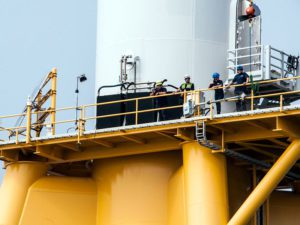
Block Island wind farm techs. Photo: Chris Bentley
California is a great place to work. There is a scale to California’s market that allows us to innovate in very interesting ways and achieve solutions on a wider scale, while at the same time drilling down on equity across every sector of the economy, economic class, and every community in the state. For us, this is a bright spot and a real joy to engage in, seeing that we can shift billions of dollars of investment to clean energy infrastructure.
My hope for offshore wind is that we can create a cutting-edge industry in California and also implement a vision for expanding green-collar manufacturing in the U.S.
There is an opportunity for California to lead the way for offshore wind. The state is well positioned to learn from the East Coast on offshore wind deployment and accelerate our work here quickly—whether it’s related to due diligence for marine conservation or equitable partnerships with organized labor. There’s a lot to do, and I’m hopeful we can get there quickly.
There is a scale to California’s market that allows us to innovate in very interesting ways and achieve solutions on a wider scale, while at the same time drilling down on equity across every sector of the economy, economic class, and every community in the state.

